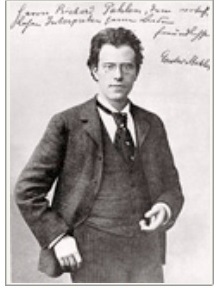 Gustav Mahler was born in Kaliste (Kalischt, in German), Bohemia (now in the Czech Republic), son of an Austrian-Jewish tavern keeper. He spent his childhood and youth in the town of Jihlava (Iglau, in German) (now in the Czech Republic), where his family moved soon after his birth. His musical talent became evident already at the age of four when Mahler started to compose piano pieces. He made his debut as a pianist at the age of ten in Jihlava, and consequently was accepted to the Vienna Conservatory at the age of fifteen. After graduation, he started a career of conductor with various provincial orchestras and opera houses, then in Hamburg, Germany, and in 1888 he was appointed director of the Budapest opera. Mahler eventually became artistic director of the Vienna Court Opera at the age of 37, having converted to Catholicism. He was widely acclaimed as a conductor, but his compositions were less welcome by the public of his time. In 1907, Mahler resigned from his position with the Vienna opera and traveled to the USA, where he was engaged as chief director at the Metropolitan Opera House and at the Philharmonic Society of New York. His failing health compelled him to come back to Europe, first to Paris, where he received medical treatment, and then he returned to Austria, staying for some time in the countryside where he composed his last works. Mahler died in Vienna at the age of 50.
Gustav Mahler was born in Kaliste (Kalischt, in German), Bohemia (now in the Czech Republic), son of an Austrian-Jewish tavern keeper. He spent his childhood and youth in the town of Jihlava (Iglau, in German) (now in the Czech Republic), where his family moved soon after his birth. His musical talent became evident already at the age of four when Mahler started to compose piano pieces. He made his debut as a pianist at the age of ten in Jihlava, and consequently was accepted to the Vienna Conservatory at the age of fifteen. After graduation, he started a career of conductor with various provincial orchestras and opera houses, then in Hamburg, Germany, and in 1888 he was appointed director of the Budapest opera. Mahler eventually became artistic director of the Vienna Court Opera at the age of 37, having converted to Catholicism. He was widely acclaimed as a conductor, but his compositions were less welcome by the public of his time. In 1907, Mahler resigned from his position with the Vienna opera and traveled to the USA, where he was engaged as chief director at the Metropolitan Opera House and at the Philharmonic Society of New York. His failing health compelled him to come back to Europe, first to Paris, where he received medical treatment, and then he returned to Austria, staying for some time in the countryside where he composed his last works. Mahler died in Vienna at the age of 50.
Although Mahler spent most of his career as an opera conductor, his compositions are symphonic, including 40 lieder that are considered by most critics to be rather short symphonic movements. His musical output includes 10 symphonies: Symphony No 1 – “The Titan”, (1888), Symphony No 2 – “The Resurrection” (1894), Symphony No 3 (1896), Symphony No 4 – “Ode to Heavenly Joy” (1900), Symphony No. 5 – “The Giant” (1902), Symphony No. 6 – “The Tragic Symphony” (1906), Symphony No. 7 – “Song of the Night” (1905), Symphony No. 8 – “Symphony of a Thousand” (1908), Symphony No. 9 (1910), Symphony No. 10 – unfinished. Mahler is also renowned for his cycles of songs with orchestra of them the best known are Lieder eines fahrenden Gesellen (“Songs of a Wayfarer”) (1884), Lieder aus Des Knaben Wunderhorn (“The Youth’s Magic Horn”) (1899), Kindertotenlieder (“Songs on the Deaths of Children”) (1901-1904), and Das Lied von der Erde (“The Song of the Earth”) (1908).